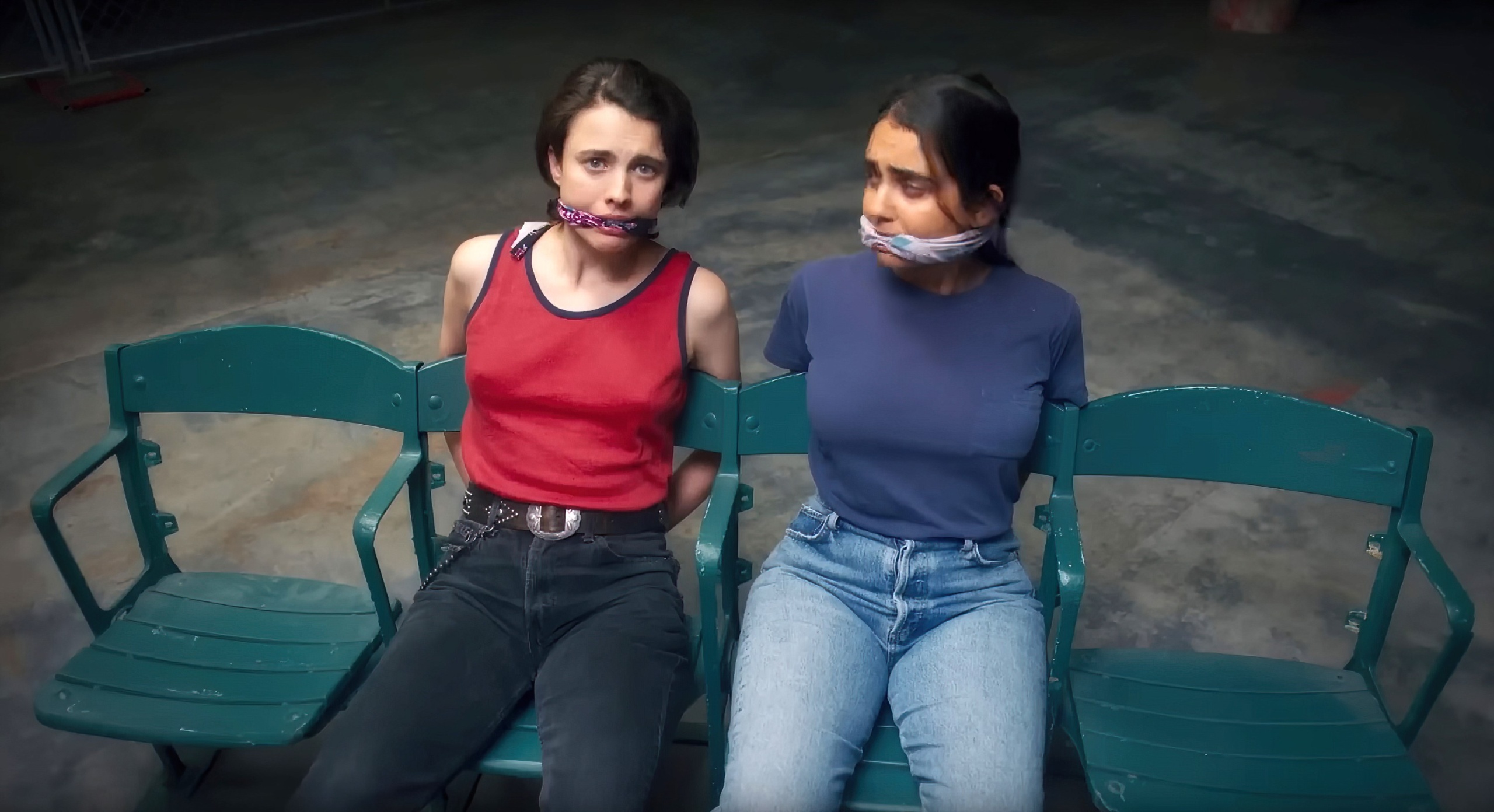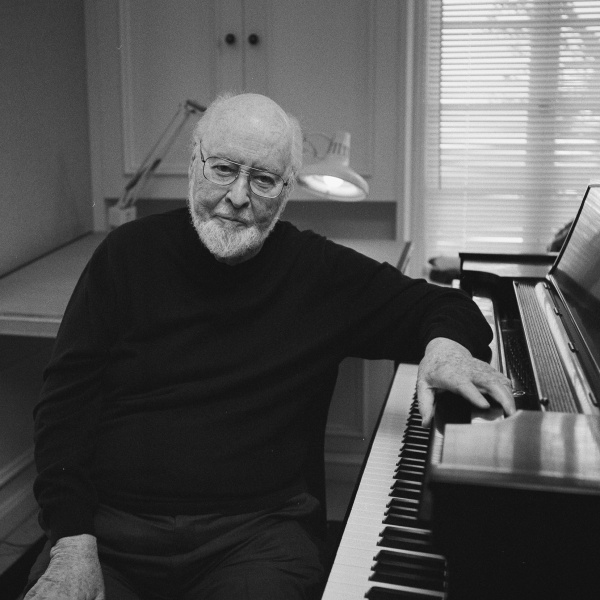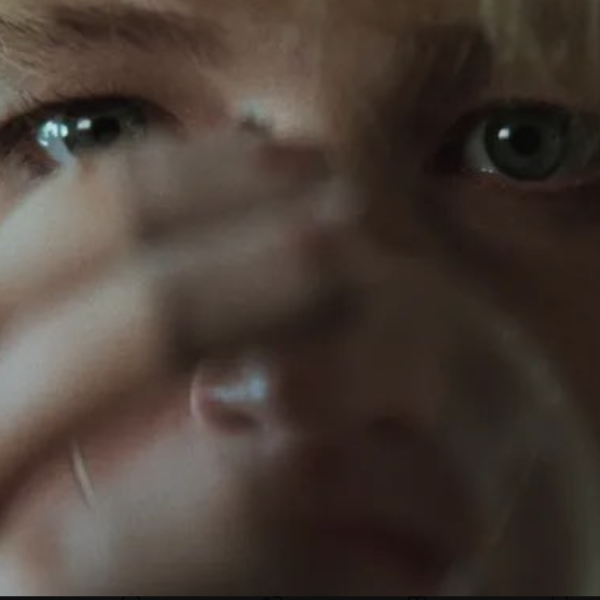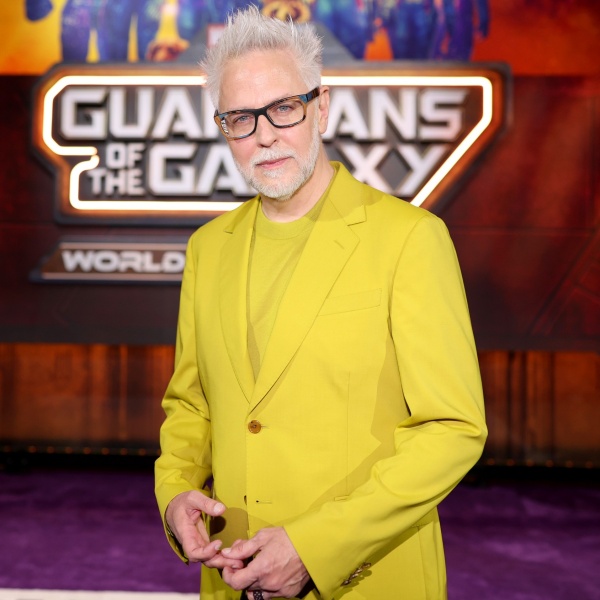“Drive-Away Dolls” is an audacious lesbian road movie inspired by such Kings of the Bs as John Waters and Russ Meyer. Two young women (Margaret Qualley and Geraldine Viswanathan) rent a drive-away car without knowing there’s cargo in the trunk that could get them in big trouble with a gang of criminals. Sure enough, thugs are soon chasing them down America’s highways.
Luckily, just about every man in the movie is a bumbling idiot. And not everyone keeps their head.
“Drive-Away Dolls” is the definition of ribald. These girls are as randy and on the make as any of their “Porky’s” counterparts. The movie wears no pretensions. It’s not going up for Oscars. It’s coming out in February, for Chrissakes!
To help promote the movie, filmmakers Ethan Coen — who accepted the Best Picture Oscar for “No Country for Old Men” back in 2008 with his usual creative partner, brother Joel — and Tricia Cooke, his wife of 30 years, shared two of their inspirations at the American Cinematheque in Santa Monica on February 15: Robert Aldrich’s deadly package movie “Kiss Me Deadly” and Paul Mazursky’s 1969 group sex romp “Bob & Carol & Ted & Alice.”
If you find those references confusing, the filmmakers were no help. “Come on, man, Elliot Gould’s undies,” said Coen in our Zoom interview with Cooke, who is the mother of their two kids. “Oh, but we don’t have undies. Yeah, so where does that fit in? It doesn’t.”
“He just makes things up,” said Cooke.
We asked Coen and Cooke to explain themselves — with a series of somewhat impertinent questions.

After Joel and Ethan worked together for 40 years, they went solo, and each of them worked with their wives, Frances McDormand (“The Tragedy of Macbeth”) and Tricia Cooke, respectively. Why?
“We each have good relationships with our spouses,” said Coen.
Did Coen and Cooke set out to make a movie that wasn’t “important”?
“Well, that’s an important thing to do,” said Coen. “There’s an underserved audience for unimportant movies, is our belief. God. Don’t you want to go to a movie?”
“It’s important to make important movies for sure,” said Cooke. “We don’t agree about this, because it’s so important to understand history and whatever is happening and different people’s perspectives on the state of the world. And sometimes it’s the only place that you’ll be able to learn those things. But it’s also important to make movies where you can just eat popcorn and not have to think about what your day is or what’s going on in the world. To escape.”
When they briefly chatted with Kristen Stewart, who read the screenplay after they had already cast their leads, she said, “We need this stupid movie.”
Did they set out to make a B movie?
“Oh, yeah,” said Coen. “Oh, very much so. And yes, not to name names — obviously, you’d never get us to— but important movies like the contemporary ones? God. Why? Why? Why?”
Was the original idea Tricia’s?
Yes. Back in 2000, she and her friend Mar Molina sat at a bar talking about road trips and cooked up the title “Drive-Away Dykes.” Cooke took it home to Ethan, who liked it. “Let’s write that movie,” he said.
Why not write it herself?
“I never thought of myself as a writer,” said Cooke. “I’ve always edited. I felt comfortable in terms of coming up with story and structure and characters. But a lot of the dialogue, that’s not something I’m comfortable doing. With Ethan, it was also a way for us to spend time together and work together. Ethan I was comfortable working with. What, are you going to say no to Ethan writing something with you?”
For Coen, “It’s the same as writing with Joel. We sit in a room together, we talk scenes back and forth. And it’s fun. Yeah, It’s stimulating. I’ve also written stuff by myself. And that can be oppressive on a good day. Working with somebody else that you are compatible with, the whole work thing is congenial. It’s just constant stimulation from outside. And it’s fun.”
When did it become a real movie?
After an iteration of the movie directed by Allison Anders never happened, the side project came back to life during the pandemic. “We had written two and a half [scripts],” said Cooke. “We also wrote a short together, that I never thought would be made. I just thought we were writing them as a hobby; our kids would find them one day and do something with them. But then, during the pandemic, we had made a documentary [Cannes entry “Jerry Lewis: Trouble in Mind”] and that had been a lot of fun to work on. So we thought, ‘OK, let’s revisit this.’ And we actually looked at both ‘Drive-Away Dykes’ and ‘Honey Don’t’ and thought ‘Drive-Away Dykes’ had more humor in it.”
They kept the period “Drive-Away Dolls” was originally written in, the early 2000s. “That’s the world I was more familiar with, going out to lesbian bars,” said Cooke. “I was doing that at the turn of the century. It’d be harder to write a contemporary movie about two young lesbians going to a bunch of lesbian or queer bars now. There are only 27 lesbian bars left in the country or something.”

Why couldn’t they keep the title they fell in love with in the first place, “Drive-Away Dykes,” which calls out what it is?
The filmmakers still refer to the movie as “Drive-Away Dykes.” But while distributor Focus Features gave lip service to liking the title, they explained that issues with the MPAA and theater marquees around the country made using it unfeasible. “It’s the biggest heartbreak,” said Cooke.
Are they co-directors when Coen gets solo director credit from the DGA? And Cooke is credited as co-writer and producer?
“No, we’re co-directors,” said Coen. “[The DGA] are appropriately passive. They don’t care as long as a member’s interests isn’t being threatened. I’m titularly the director because I’m already a member of the Guild. And we don’t care about the titles, it’s the easy default title for me.”
Said Cooke, “We made it together, we made all the creative decisions and choices together. Ethan’s been doing it for so long. And I’ve never really done it. I’ve done little shorts. So there are things that he’s more comfortable doing. He would primarily talk to the actors, but we would collaborate behind the camera, and sometimes I would direct the actors as well.”
As with writing, Coen compares directing with Cooke to directing with Joel. “We think about it as we write the movie together,” he said. “That’s the beginning of making the movie. We make the movie together, we cut the movie together. And the distinctions between roles, writing, directing, when you’re writing you’re making ‘directorial choices,’ you’re thinking about how the scene is going to play, what it’ll look like, the roles, the function descriptions are all a little artificial. We’re making the movie together, just as me and Joel made movies together.”
There’s strength in numbers, said Cooke: “When things are falling through the cracks, the other person is there to pick up the slack or make sure that none of that is overlooked. And it just makes it a little bit easier. Everything gets its proper attention.”

Would Coen ever want to direct alone?
“Oh, no!” he said. “Make a movie without Trish or Joel? No, I don’t think so. I don’t even think about it. You can see I’m considering it for the first time. I’ve written other plays by myself, but somebody else directed them. Seriously, I’m thinking about it. No, I don’t think I would.”
Is he going to direct another movie with Joel again?
“We’ve written something that, yeah, we’re going to do,” said Coen. Their last movie together was “The Ballad of Buster Scruggs” in 2018.
How did they find the two actresses to play the lesbian romantic leads?
Both actresses auditioned in person, but never together. The filmmakers gambled they would work. “Geraldine we saw pretty early on and we loved her,” said Cooke. “We watched her in ‘Blockers’ and thought she was really great and funny. She embodied Marian, immediately she got it. And, she’s got great comedic timing. And Margaret came in a little bit later. Personality-wise, she felt the closest to Jamie: free-spirited and flops around and throws caution to the wind. And that was the sense that we got from Margaret as a person. And then we saw a Spike Jonze dance commercial that he had cut with her. She’s so wild and goofy in it. And we thought, ‘That’s perfect.’ They came together and had really, really good chemistry. They became fast friends.”
“Yeah, they’re both so clearly good,” said Coen. “They both just lit it up. And why would they fail to light it up together?”
How did they persuade Pedro Pascal, Bill Camp, Colman Domingo, and Matt Damon to appear in cameos?
By giving them good parts, said Coen. “From their point of view, they read the script. They go, ‘OK, it would be fun to do this.’ That’s why you know if you’re established. After that you can do whatever you want, and you see a part that you go, ‘Oh, I can chop some wood with this. I can make hay with this.’ I’m sure you can tell they attack their roles with relish.”

Was it fun applying the tropes for randy boys to randy girls?
“That was the idea,” said Cooke. “Sex can be fun. And it can be raunchy. Still there can be an innocence too, we just wanted it to be nasty and a little trashy, but also kind of pure.”
There’s a “straight romance” at the center?
“Yes, it was important to us that it be innocent and sweet and raunchy,” said Coen. “And all those men!”
Are they all buffoons?
“We were pretty clear,” said Coen, “that if the character was a man, they were in over a dumbbell.”
Did you storyboard everything, just like Ethan and Joel would do?
“We do have a plan for the whole thing,” said Coen, “and the plan might change.”
They took storyboards that had been in a drawer for 20 years and used them as a first draft. Cooke made a shot list, and Coen did a rough crude thumbnail sketch of what they had in mind before their usual storyboard artist J. Todd Anderson took over.
“And in the process of doing that, you’re describing the shot. It gets refined and changed, and it is a little different,” said Coen. “After we go through with J. Todd.”
Action scenes need to be choreographed and acted out a bit, with the storyboard artist on hand, “so he can get a sense of where the camera’s going,” said Cooke.
“Yeah, action stuff tends to get put down more precisely,” said Coen. “Because it’s so many bitty pieces, you have to know what pieces you need with a high degree of specificity.”

Who came up with the wall dildo?
At the time they were writing the script, Cooke was working with someone who was a manager of a sex toy shop on the Lower East Side. “A lot of apparatuses were coming up and we thought, ‘OK, well, where can we put a dildo that would be fun?’ And then everyone on set, is like, ‘OK, Tricia, how high is the wall dildo?’”
Does making a silly movie mean you are free from the pressure of having to deliver a great movie?
“Coming up with silly ideas,” said Cooke, “and thinking, ‘this would be fun, how do we work this into the structure of the movie?’ We felt at liberty to do that. Because we weren’t trying to say much. There’s not a lot of earnestness. The points for me are: men can be clueless, or, women are powerful, strong, fun, interesting characters, or you can put queer people in the movie, and it doesn’t necessarily just have to be about them being queer, they can be in a genre movie. All of those things I wanted to say in that movie.”
Added Coen: “And you can have a raunchy boy movie, except it’s girls.”
Did they like collaborating enough todirect together again?
“Yeah!,” they chime in together. “Honey Don’t” is prepping now in Albuquerque, where they called me from the production office, with the shooting calendar behind them on the wall. “It’s a contemporary private eye crime,” said Coen. “A woman is dead. Is she a traffic fatality or not? Mystery!”
“And we took the detective tropes and swapped them,” said Cooke. “We’ve got the femme fatale woman as the prime detective.”
She’s played by Margaret Qualley.
A Focus Features release, “Drive-Away Dolls” is now in theaters.




